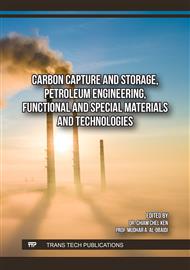[1]
M. R. Sule, W. G. A. Kadir, T. Matsuoka, H. Prabowo, and G. S. Sidemen, "Gundih CCS Pilot Project: Current Status of the First Carbon Capture and Storage Project in South and Southeast Asia Regions," SSRN Electron. J., no. Jcm, 2020.
DOI: 10.2139/ssrn.3366415
Google Scholar
[2]
P. Fragkos et al., "Energy system transitions and low-carbon pathways in Australia, Brazil, Canada, China, EU-28, India, Indonesia, Japan, Republic of Korea, Russia and the United States," Energy, vol. 216, 2021.
DOI: 10.1016/j.energy.2020.119385
Google Scholar
[3]
M. T. Sambodo et al., "Breaking barriers to low-carbon development in Indonesia: deployment of renewable energy," Heliyon, vol. 8, no. 4, p. e09304, 2022.
DOI: 10.1016/j.heliyon.2022.e09304
Google Scholar
[4]
R. Ramadhan, M. T. Mon, S. Tangparitkul, R. Tansuchat, and D. A. Agustin, "Carbon capture, utilization, and storage in Indonesia: An update on storage capacity, current status, economic viability, and policy," Energy Geosci., vol. 5, no. 4, p.100335, 2024.
DOI: 10.1016/j.engeos.2024.100335
Google Scholar
[5]
A. Rahman, R. Richards, P. Dargusch, and D. Wadley, "Pathways to reduce Indonesia's dependence on oil and achieve longer-term decarbonization," Renew. Energy, vol. 202, no. February 2022, p.1305–1323, 2023.
DOI: 10.1016/j.renene.2022.11.051
Google Scholar
[6]
B. T. H. Marbun et al., "Well integrity evaluation prior to converting a conventional gas well to CO2 injector well – Gundih CCS pilot project in Indonesia (phase 1)," Int. J. Greenh. Gas Control, vol. 88, no. July 2019, p.447–459, 2019.
DOI: 10.1016/j.ijggc.2019.06.006
Google Scholar
[7]
M. T. Mon, R. Tangsuchat, and W. Yamaka, "CCUS Technology and Carbon Emissions: Evidence from the United States," Energies, p.1–17, 2024.
DOI: 10.3390/en17071748
Google Scholar
[8]
R. Ramadhan et al., "Geomechanics contribution to CO2 storage containment and trapping mechanisms in tight sandstone complexes : A case study on Mae Moh Basin," Sci. Total Environ., vol. 928, no. January, p.172326, 2024.
DOI: 10.1016/j.scitotenv.2024.172326
Google Scholar
[9]
A. N. Rakhiemah and Y. Xu, "Economic viability of full-chain CCUS-EOR in Indonesia," Resour. Conserv. Recycl., vol. 179, no. November 2021, p.106069, 2021.
DOI: 10.1016/j.resconrec.2021.106069
Google Scholar
[10]
D. Adisaputro and B. Saputra, "Carbon Capture and Storage and Carbon Capture and Utilization : What Do They Offer to indonesia ?," Front. Energy Res., vol. 5, no. March 2017, p.2012–2015, 2017.
DOI: 10.3389/fenrg.2017.00006
Google Scholar
[11]
J. G. Maas, N. Springer, A. Hebing, J. Snippe, and S. Berg, "Viscous fingering in CCS - A general criterion for viscous fingering in porous media," Int. J. Greenh. Gas Control, vol. 132, no. September 2023, 2024.
DOI: 10.1016/j.ijggc.2024.104074
Google Scholar
[12]
H. C. Lau, "Decarbonization of ASEAN's power sector: A holistic approach," Energy Reports, vol. 9, p.676–702, 2023.
DOI: 10.1016/j.egyr.2022.11.209
Google Scholar
[13]
N. Kumar et al., "Carbon capture and sequestration technology for environmental remediation: A CO2 utilization approach through EOR," Geoenergy Sci. Eng., vol. 234, no. September 2023, p.212619, 2024.
DOI: 10.1016/j.geoen.2023.212619
Google Scholar
[14]
S. Jitmahantakul, P. Chenrai, T. Chaianansutcharit, T. Assawincharoenkij, A. Tang-on, and P. Pornkulprasit, "Dynamic estimates of pressure and CO2-storage capacity in carbonate reservoirs in a depleted gas field, northeastern Thailand," Case Stud. Chem. Environ. Eng., vol. 8, no. April, p.100422, 2023.
DOI: 10.1016/j.cscee.2023.100422
Google Scholar
[15]
S. Efe et al., "A general review of CO2 sequestration in underground geological formations and assessment of depleted hydrocarbon reservoirs in the Niger Delta," Appl. Energy, vol. 350, no. August, p.121723, 2023.
DOI: 10.1016/j.apenergy.2023.121723
Google Scholar
[16]
H. K. Bokka and H. C. Lau, "Decarbonizing Borneo's power and industry sectors by carbon capture and storage," Geoenergy Sci. Eng., vol. 226, no. September 2022, p.211796, 2023.
DOI: 10.1016/j.geoen.2023.211796
Google Scholar
[17]
K. Zhang and H. C. Lau, "Regional opportunities for CO2 capture and storage in Southeast Asia," Int. J. Greenh. Gas Control, vol. 116, no. February, p.103628, 2022.
DOI: 10.1016/j.ijggc.2022.103628
Google Scholar
[18]
H. C. Lau, "The Contribution of Carbon Capture and Storage to the Decarbonization of Coal-Fired Power Plants in Selected Asian Countries," Energy and Fuels, 2023.
DOI: 10.1021/acs.energyfuels.3c02648
Google Scholar
[19]
H. C. Lau, "Decarbonization roadmaps for ASEAN and their implications," Energy Reports, vol. 8, p.6000–6022, 2022.
DOI: 10.1016/j.egyr.2022.04.047
Google Scholar
[20]
S. K. Hansen, Y. Tao, and S. Karra, "Impacts of Permeability Heterogeneity and Background Flow on Supercritical CO2 Dissolution in the Deep Subsurface," Water Resour. Res., vol. 59, no. 11, 2023.
DOI: 10.1029/2023WR035394
Google Scholar
[21]
X. Fang et al., "Effects of Reservoir Heterogeneity on CO2 Dissolution Efficiency in Randomly Multilayered Formations," Energies, vol. 16, no. 13, 2023.
DOI: 10.3390/en16135219
Google Scholar
[22]
E. A. Al-Khdheeawi, S. Vialle, A. Barifcani, M. Sarmadivaleh, and S. Iglauer, "Impact of reservoir wettability and heterogeneity on CO2-plume migration and trapping capacity," Int. J. Greenh. Gas Control, vol. 58, p.142–158, 2017.
DOI: 10.1016/j.ijggc.2017.01.012
Google Scholar
[23]
M. Abdurrahman, A. K. Permadi, and W. S. Bae, "An improved method for estimating minimum miscibility pressure through condensation – extraction process under swelling tests," J. Pet. Sci. Eng., vol. 131, p.165–171, 2015.
DOI: 10.1016/j.petrol.2015.04.033
Google Scholar
[24]
Y. Zhao and Q. Yu, "CO2 breakthrough pressure and permeability for unsaturated low-permeability sandstone of the Ordos Basin," J. Hydrol., vol. 550, p.331–342, 2017.
DOI: 10.1016/j.jhydrol.2017.04.050
Google Scholar


